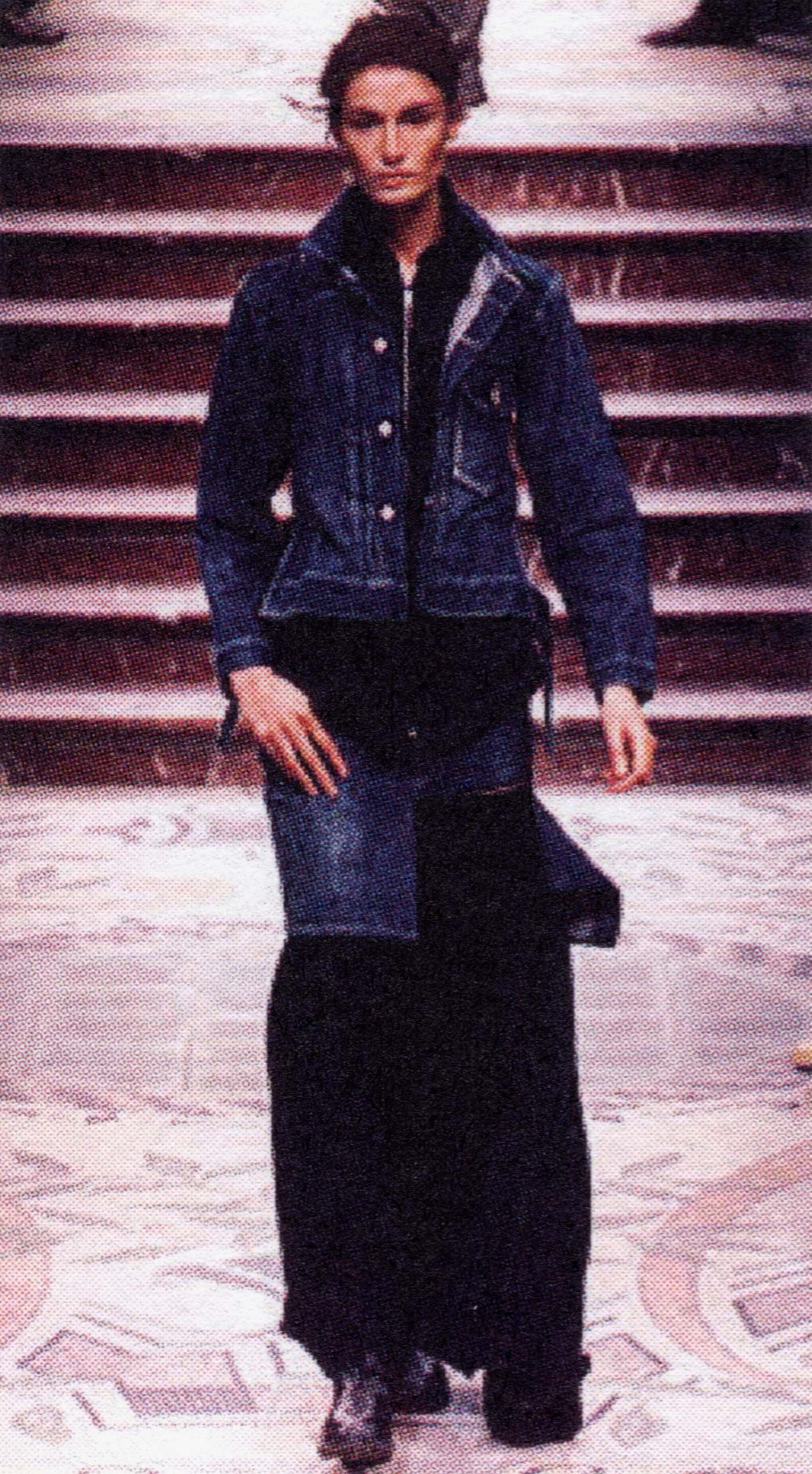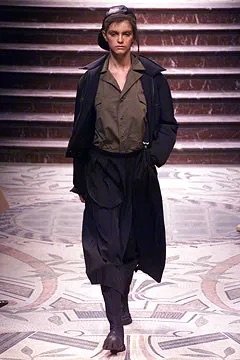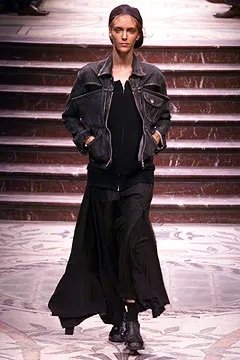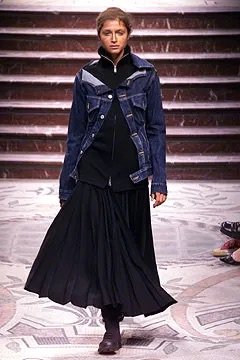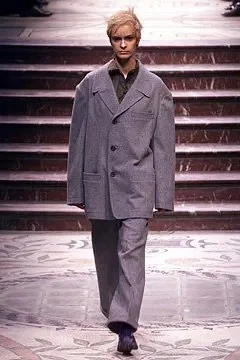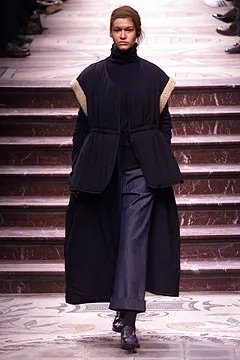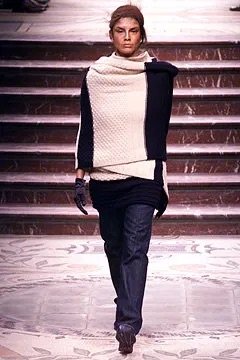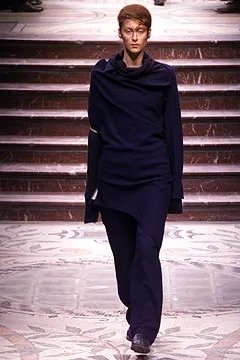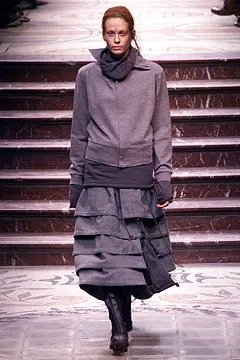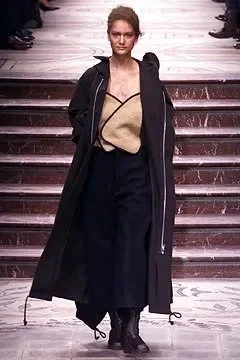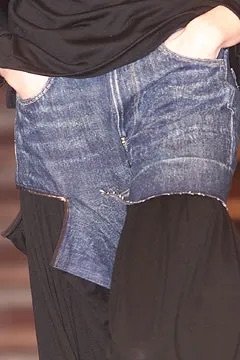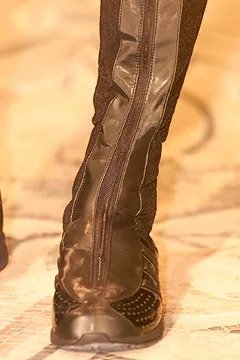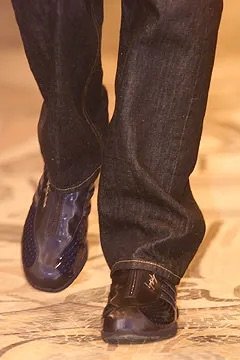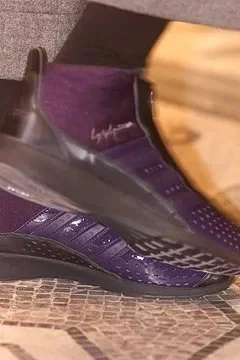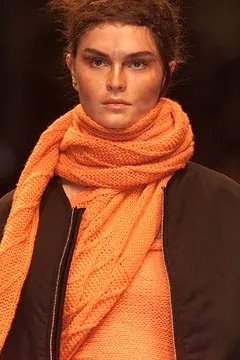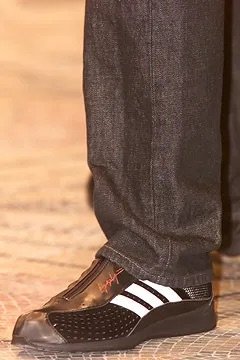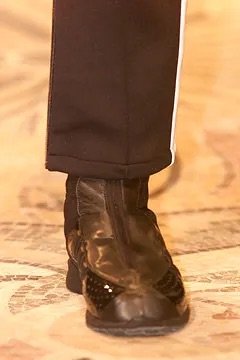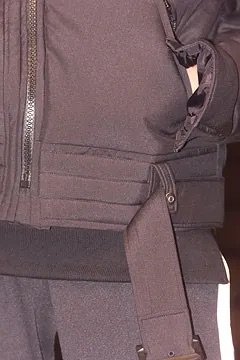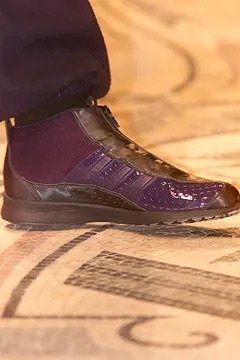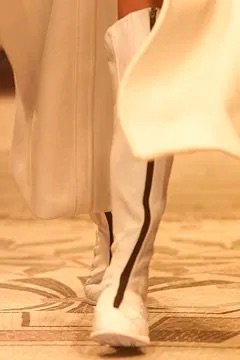Yohji Yamamoto
Autumn/Winter 2002-2003
Yohji Yamamoto Collections
2014
Yamamoto & Yohji
Published by Rizzoli
Baseball hats, jackets, and knitted coverings compose a casually harmonious silhouette emphasized by jeans, which, no longer content with their classic status, permit themselves all sorts of novelties. As for the tops, the guardians of the temple, they weave a highly desirable weft of Olympian elegance.
Yohji Yamamoto Fall 2002 Ready-to-Wear
March 6, 2002
Vogue
Written by Sarah Mower
Yohji Yamamoto's riffs on sport-meets-couture-meets-Japanese-asymmetry have lasted a couple of seasons now. But even though other designers have been coming up on the outside with zippy track suits, hoodies and parkas this season, Yohji is still out in front.
As is his wont, Yamamoto mixed street sport pieces with military drab, denim, knit, biker leathers and traditional suit and coat fabrics. He started out with trompe l'oeil biker jackets which were fused with skirts to look like coats, then cut up denim to layer over zipped sweats and long, elegant black pleated skirts. Oversized men's suits stumbled on the asexual side, but the designer's 20-year obsession with the formal structures of Western couture put him back on track. He cut tailcoats in khaki and worked graphic leather patches into black jackets and suits. A navy melton peacoat and a long coat cut with three-quarter-length puffed sleeves bordered on modernist Balenciaga.
Ultimately, this show was a bit of a marathon complete with some uphill moments. And when Yamamoto reached the finish line via parkas and nylon jackets with wings painted on the back, it wasn't certain whether he was conjuring heavenly seraphims or Hell's Angels. Either way, the audience cheered.
The Collections / Paris : Forward-looking designers go back to their roots
March 9, 2002
International Herald Tribune
Written by Suzy Menkes
The powerful shows that have hit the runways — Bang! Bang! Bang! — in the first two days of the autumn/winter 2002 have a collective thread. Designers are going back to their roots.
That does not mean a rerun of greatest hits, but for designers as different as Rei Kawakubo of Comme des Garcons and John Galliano at Dior to emphasize what they have always stood for and how they project that spirit for modern times. […]
Yohji Yamamoto was on a different tack, following the sporty inspiration of his year-old collaboration with Adidas. As the cute boxing boots and sneakers walked the mosaic floor under the painted baroque ceiling of the Petit Palais, Yamamoto's long collection seemed almost too brilliant to take in. Eclectic borrowing from the male wardrobe meant that even the simplest bomber jacket morphed into something else: a zippered blouson turning into a long coat at the back; or denim cut up and pasted on in a childish way.
And then it suddenly dawned that Yamamoto, better known for dour romance, was being playful, even offering up his revered name as a double "Y" logo.
"It was like children playing in the country or a mother making clothes by cutting up their father's things," said Yamamoto backstage to explain the muddy dirt rubbed into the models' faces and legs.
The clothes were sometimes tricky, as multidrawstrings turned hemlines into parachutes. But there were also wonderfully simple pieces, like the thick knit stoles in orange and marigold, lapping the body from a pair of sleeves; or even the oversized men's suits that referenced Yamamoto's earlier work; there were also fine tailored coats and the fall season's must-have: the tail coat, cut away over pants. The sheer design energy in the collection was heart warming and for that Yamamoto received a deserved ovation. […]
2002-2003秋冬パリ、ミラノ、ロンドン、ニューヨーク・コレクション。
2002-2003 Autumn & Winter World Collections
June 2002
High Fashion No.285
Photography by Shin Shin and Koichiro Matsui
Report by Ikuko Fujii and Misako Tamagawa
スポーツ、ワークという現代の日常着をベースに、アディダスのロングブーツを履いて闊歩する、生き生きとした女性像をつくり出した。ジャージーと継ぎ合わせたデニム、レザーのライダーズコート、燕尾風トレンチとジップアップのカットソー、ライン入りパンツの組合せ。シルクのブルゾンの背中には、手がき友禅の羽やLOVEの文字。ギャザースリーブのピーコートやオーバーサイズのジャケット、体に巻きつけたローゲージニットなどの量感。すべては活動的なプロポーションで展開されているが、洗練に裏打ちされた、都会の新しいフェミニニティなのだ。
Based on modern everyday wear such as sportswear and workwear, the collection created a lively image of a woman strutting around in Adidas long boots. It featured a combination of spliced jersey and denim, leather rider's coat, swallow-tail-styled trench coats, and zip-up cut-and-sewn and lined pants. On the back of silk blousons, hand-drawn yūzen feathers and the word "LOVE" were emblazoned. Peacoats with gathered sleeves, oversized jackets, and low-gauge knit wrapped around the body have a sense of volume. Everything has dynamic proportions, but, underpinned by sophistication, it's a new urban femininity.
1981/2002
2002
Yohji Yamamoto: Talking to Myself
Published by Steidl/Carla Sozzani
Photography by Paolo Roversi
WINTER 02/03
Petit Palais
A father's clothing tailored for his daughters by a war widow... this is the touching description of the designer's very personal fashion. Using ingenious cuts and collages, these hybrid clothes pulled from the military universe bring past and present together, redefining a femininity that displays its own masculine elements. And our guardian angels sweep their wings over the backs of jackets and coats. "I want to design time," repeats Yohji Yamamoto.
山本耀司 AtoZ
Yohji Yamamoto AtoZ
March 2011
FASHION NEWS Special Vol.161
Uniform
「女のユニフォームを作りたいんだよ」
労働しているその姿が美しい。働く女性に向けた新しいユニフォーム。そんなコンセプトで「Y's」は立ち上がった。80年代は特に、〝フェミニスト〞というスタンスでデザインしてきた。「イヴ・サンローランがディオールから独立したとき、街の清掃局員のユニフォームから着想した作品があった。クチュリエが最初に捧げたオマージュのひとつが“つなぎ”だった」。もちろん、耀司も、労働着がモードの中で市民権を得ることに尽力した一人だ。
"I want to make uniforms for women."
Beautiful in her labor. A new uniform for working women. "Y's" was launched with this concept in mind. In the 1980s, there was a particularly "feminist" stance in design. "When Yves Saint Laurent left Dior, he had a piece inspired by the uniforms of city sanitation workers. One of the first homages that the couturier paid was to the "boiler suits." Yohji, of course, was one of those who helped the work uniform gain respectability within fashion.
パリコレ30年の軌跡
30 Years of Paris Collection
March 2011
FASHION NEWS Special Vol.161
戦争で夫を亡くした寡婦が夫の古着を娘のために仕立て直した服、という耀司の個人的なイメージをインスピレーション源にしたシーズン。テーマは「リメイク」。ミリタリーやトレンチコート、デニムをコラージュした服。友禅で描いた天使の羽根がユーモラスだ。
The season was inspired by Yohji's personal image of a widow who lost her husband in the war and re-tailored his old clothes for her daughter. The theme was "Remake". The clothes are collages of military wear, trench coats, and denim. The yūzen angel wings are humorous.
たかが服、されど服 ――ヨウジヤマモト論
2010
Published by 集英社
Archives Yohji Yamamoto Paris Women’s Collection 1981-’82 Autumn/Winter - 2014 Spring/Summer
2014
All About Yohji Yamamoto from 1968
Published by Bunka Publishing Bureau
Backstage of Yohji Yamamoto, Autumn/Winter 2002-2003
2006
Yohji Yamamoto: An Exhibition Triptych
Published by The Press
Photography by Donata Wenders
ヨウジヤマモトのニューモデル
Yohji Yamamoto's new model
August 2002
SO-EN
Photography by Higashi Ishida
Hair & makeup by Katsuya Kamo (Mod's Hair)
Modeling by Mandi Wright
Coordination & text by Naoko Kikuchi
トレンチコート、ピーコート、ライダーズジャケット、デニムジャケット―――、どれも服の原型とも言うべきアイテムであり、あたりまえのように現代生活に密着したスタイルだ。記号のような意味合いを持つ定番には、モデルや素材でインプットされた形が存在する。その原型を壊して作り替えた斬新なアイディアは、2002年ヨウジヤマモトのニューモデルとして再生した。
Trench coats, pea coats, riders' jackets, denim jackets… All of these items are archetypes of clothing, styles that are as much a part of modern life as they are the norm. Standard items, which have a meaning like a symbol, have a form imprinted with a pattern and fabric. The innovative idea of breaking down the archetypes and reworking them was reborn as a new model for Yohji Yamamoto in 2002.
RIDER'S COAT
ハードな馬革のロング丈のライダーズコートをミニワンピースと組ませて軽快に。ライダーズコート¥400,000、ワンピース¥53,000、ロングブーツ¥70,000 ヨウジヤマモト
TRENCH COAT
ゆったりとしたラグランスリーブのトレンチコートはウールの重厚感が新鮮。トレンチコート¥160,000、ニット¥40,000 ヨウジヤマモト/ロングブーツ¥48,000 アディダスフォーヨウジヤマモト(ヨウジヤマモト)
RIDER'S COAT
A long, hard horse leather rider's coat is paired with a mini dress for a lighthearted look. Rider's coat ¥400,000, dress ¥53,000, long boots ¥70,000 Yohji Yamamoto
TRENCH COAT
This trench coat with relaxed raglan sleeves has a fresh, heavy wool feel. Trench coat ¥160,000, knit ¥40,000 Yohji Yamamoto / Long boots ¥48,000 adidas for Yohji Yamamoto
MOD'S COAT
ワークウェア風なモッズコートはポケットの裏布のファーがポイント。ドローストリングづかいと衿のワイヤの表情を楽しんで。コート¥130,000、ワンピース¥80,000 ヨウジヤマモト/ロングブーツ¥40,000 アディダスフォーヨウジヤマモト(ヨウジヤマモト)
DENIM JACKET
切替えを入れたデニムジャケットとジップアップスウェットを合体させたユニークなデザインのニューモデル誕生。デニムジャケット¥150,000、ギャザースカート¥70,000 ヨウジヤマモト
MOD'S COAT
The main feature of this workwear-style mod’s coat is the fur lining of the pockets. Enjoy the look of the drawstring and the wire on the collar. Coat ¥130,000, dress ¥80,000 Yohji Yamamoto / Long boots ¥40,000 adidas for Yohji Yamamoto (Yohji Yamamoto)
DENIM JACKET
A new model with a unique design combining a denim jacket and a zip-up sweatshirt was born. Denim jacket ¥150,000, gathered skirt ¥70,000 Yohji Yamamoto
PEA COAT
ギャザースリーブがキュートなピーコートはベーシックアイテムのニュレースタイル。ギャザースリーブコート、¥100,000、ニット¥42,000、ミニスカート¥35,000 ヨウジヤマモト/ロングブーツ¥40,000 アディダスフォーヨウジヤマモト(ヨウジヤマモト)
RIDER'S JACKET
ハードなイメージのライダーズモデルをダウン風にライトに作り替えた新型デザインが魅力。ジャケット¥220,000、ボーダートップ¥30,000、パンツ¥28,000 ヨウジヤマモト
PEA COAT
A pea coat with cute gathered sleeves is a basic item in a nuanced style. Gathered sleeve coat, ¥100,000, knit ¥42,000, mini skirt ¥35,000 Yohji Yamamoto / Long boots ¥40,000 adidas for Yohji Yamamoto (Yohji Yamamoto)
RIDER'S JACKET
The appeal of this new design is that it is a light, down-style version of the hard-edged riders' model. Jacket ¥220,000, striped top ¥30,000, pants ¥28,000 Yohji Yamamoto
DENIM SET UP
デニムとニットジャージーの異素材ミックスでクチュール風に仕立てたニューカジュアルスタイル。デニムジャケット¥150,000、スカート¥100,000 ヨウジヤマモト/スニーカー¥26,000 アディダスフォーヨウジヤマモト(ヨウジヤマモト)
RIDING COAT
軽快なシルク製ダウンのライディングコートは、日常着から進化したおしゃれアイテムまで幅広い対応。ロングコート¥260,000、ニット¥26,000、スウエットパンツ¥30,000 ヨウジヤマモト/ロングブーツ¥48,000 アディダスフォーヨウジヤマモト(ヨウジヤマモト)
DENIM SET UP
A new casual style tailored in a couture style with a mix of denim and knit jersey in different fabrics. Denim jacket ¥150,000, skirt ¥100,000 Yohji Yamamoto / Sneakers ¥26,000 adidas for Yohji Yamamoto (Yohji Yamamoto)
RIDING COAT
A lightweight silk down riding coat can be used for a wide range of purposes, from everyday wear to an evolved fashionable item. Long coat ¥260,000, knit ¥26,000, sweat pants ¥30,000 Yohji Yamamoto / Long boots ¥48,000 adidas for Yohji Yamamoto
記号化した古着:山本耀司が語る、最新クリエーション
Encoded Vintage Clothing: Yohji Yamamoto Talks about His Latest Creation
August 2002
SO-EN
Photography by Roland Hagenberg (portrait), Josui Yasuda (still life, B.P.B.), and Monica Feudi (collection)
Editing by Kazushi Takahashi
Interview by Nobuko Kojima
「抽象的な服を作るのは飽きた。今回は楽しかった」
"I got tired of making abstract clothes. This season was fun."
「ストーリーは東欧の貧しい一家。母親が子供のために一着ずつ手作りで服を作ってあげる。戦地に赴いて今は家にいない父親の古着を使って」
解体と再生
山本耀司は服作りを、前回より0.5ミリでも前に進めるかどうかの自分との戦いだという。だがその0.5ミリは大きい。時間と感覚と意識をまだ何もない所に投げかけ、できた服を着る人を、見る人をそこまで引き寄せることなのだから。2002-2003秋冬パリ・コレクションで、彼は作業着や戦闘服をパートナーに選んだ。無名の作り手の技と潜り抜けてきた長い時間に敬意をこめて。解体し、再生することで、日常の服は新しい命を得て、昨日から明日へ歩き出した。
作業着の解体
「今、この瞬間生きていて、いちばんかっこいいと思うものをストリートから拾ってくること」。パタンナーや素材の企画担当に向けられたこの指令で、今回のコレクションは動き始めた。彼らが集めてきた中から、さらに選び抜かれた服がプレスルームにあった。洗い晒されて白っぽくなったデニムのジャンパー、フードの縁に針金の入ったフィールドパーカ、肩章のついたアーミージャケット、堅牢なウールのピーコートなど10着ほどのヴィンテージ。最高の素材と伝統の技術を駆使して個人のための完璧な服を作るのが従来のオートクチュールなら、肉体労働のためにできるだけ機能的で、丈夫で、安価に作られた大量生産の服は、その対極にあるのかもしれない。どちらが美しいかという問いかけはもはや無意味だ。21年前パリに乗り込んで、理想的な立体にはめ込めばよしとする西洋の美意識をオーバーなサイズで解体し始めたように、彼は一方の伝統ともいえる労働者を分解し、愛すべき創意工夫の精神をくみ取り、ユーモアを抽出し、現代のエレガントな女性の服へと再構築していった。前者が反抗ならば、後者は共同戦線として。
2002年3月7日、コレクションは、プティ・パレで行なわれた。タンゴの調べに乗って登場したのはライダーズジャケットの裾を伸ばしたロングコート、フライトジャケットとロングスカート、そしてデニムのオーバーオールを切り開いたジャンパースカート。武骨さと重さが消えて、シンプルな機能性と軽快さが残されている。後ろ前にかぶったキャップ、スニーカー風のブーツがかわいい。ジージャンのシリーズは、極上の素材をまな板に乗せてほくほくしているシェフのような腕の冴。後姿はほとんど原型のまま、胸ポケットを立体的にしたり、ウエストを絞ったり、衿あきを広げたりの変化で、柔らかなスカートに調和するシックな服になっている。ことにジーンズの一部分を切り取って波打つほど薄いジャージーを合わせたボトムは、クチュールのテクニックを知り尽くしてこそ作れる、ミックス感覚の頂点ともいえそうだ。こうしてトレンチコートがスタジャンが、クラシックに、エスニックに、ボヘミアンに、というよりヨウジヤマモトそのものになった。
「深い意味はないですよ」と彼はいう。「抽象的な服を作るのに飽きただけ。強いていえば、はかないうねりの中に流されているモードから服を取り戻そうと」。最初の発想も素朴なものだった。「少し昔の貧しい一家。着るものがない娘のために、母親が古い軍服を縫い直して1着のジャケットを作る。原点みたいなパーソナルで暖かい服をイメージしました」。作る側はプロなので、手作りらしさを残すのは難しい。「深刻な表現は誰にでもできる。ボケをかます⋯⋯熟練がボケた時のおもしろさを大事にしています」。どこにかますかは、相手を知らなければならない。オートクチュールを徹底的に研究したように。集めた服を見ながら「これはカフスのボタンが外側だから一般の作業用ですね。工場用だったら引っ掛からないように内側についている」などと、用途、素材、ディテール について異常に詳しい。Y'sを始めた頃、10年着られる服を目指したり、軍隊払い下げの毛布で作ったジャケットが飛ぶように売れたというから、古着はもともと好きなのだ。「この補強のカンヌキがたまらない」とか「ミシンが踊っています。大量生産の音がする」とか、その思い入れはバイクマニアが改造車を作るノリではないかと思うほど。
彼の定義によると「用途とは別に都会で着ることがファッション」。そういえば男ものを取り入れたことで知られるシャネルはツイードやジャージーを、サンローランはサファリのトレンチコートをパリの流行服にした。ではこのごついやつをどうして女ものに変えるのか。「どの部分もまっすぐ縫った作業着を女性の立体にしていこうとすると、距離が足りない。思いきり破いたり切ったりすることで、寸法が流動的な肉体に間に合ってくる。曲線が生まれる。胸を高さとして理解するとダーツをとったり切り替えを入れたりしなければならないけれど、肩からウエストへの距離とすればダーツはいりません。ある一定のシルエットに向かって距離感を出せばいい。分量と布地の落ちで解決できます」。布の2つの特性⋯⋯〝張り〟と、〝落ち〟の操り方を知り尽くした、手練れの技が存分に発揮されている。「そこらへんにあるものを題材に遊んで楽しかった。発想の段階ではもっとかっこよかったんですけど」
記号の再生
日常に浸透したポピュラーなものは、服でも靴でもバッグでも多くの記号を持つ。記号とは辞書によると、〝社会習慣的な約束によって、一定の内容を表わすために用いられる文字、符号、標章などの総称〟。たとえばある製品のロゴは、人々に伝統、高級などの共通のイメージをもたらす。ピーコートといえば水兵や船員が着るダブルのショートコート。風向きによって変えられる打ち合わせや手を温めるための縦に切ったポケットなど、多くの機能はピーコートを認知させる記号でもある。「ところが記号が古くなってしまった。いちばんの特徴である目の詰んだ厚いウールさえ、もう織れる工場がない。古着は特殊素材のため、ほとんど僕たちの手には入りません。今は、縦糸横糸が透けて見えるような布ばかり」。体を酷使する仕事が減ったり、化学繊維に変わったりで、時代に合わなくなった記号を再生しなければならない。「この頃、ファッションデザインそのものが過去に作ったものの焼き直しみたいになっていて、スタイリングが新しければいいと。その一種やるせない軽さに対してどうせやるなら記号という殻だけになったものからはらわた掴み出して、ピーコートは、フライトジャケットはこんなにかっこよかったんだと証明したい。お前よりよく知ってるんだって、老人のたわごとで」
ポイント1は「用途が決まっている服は、そのいちばんおいしいところをどれだけ無駄使いするか」。記号は記号として用途とは別の使い方をする。耀司流にいえば、〝遊ぶ〟そして〝ファッションにする〟ということ。まずは布地という記号の再生⋯⋯ジーンズのデニムも、トレンチコートのウールギャバジンも、テキスタイルはすべてオリジナルだ。「デザイナーがどうやってもできない、何十年もの時間が作る味わい」が欲しいときは、エイジング加工を施す。「古いデニムは〝すり切れた〟が記号になっているので」。ポイント2は「異常接近しないほうがいい。似て非なるものだったら、本物買ったほうがいいじゃん、ということになってしまう。遊んで、しゃれをきかすこと」。コレクションのある場面では、さまざまな服の背中に天使の羽根が染めてあった。「天使のモチーフはいろんな記号に使われていて、ちょっとしたことでアーミーになったり、ブラックユーモアになったりもするのがおもしろくて。何となくエンジェル」。プリントだけでなく、手描き友禅の羽根もある。「人と同じじゃいやでしょ」と問いかけているような、けっこうきつい〝しゃれ〟なのだ。
アディダスとのコラボレーションも、今回のブーツで3シーズン目。「アディダスの原型は、いかに速く走れるかという特定の目的に向かって手作業でシューズを作り、優勝者を出すこと。研究の行き着いた先が、ハイテクノロジーでした。今までの服装文化にない不思議なもの、他から見ると醜悪なものが、街を歩き出したらかっこよく見えて、3本線が記号として認知された。ただし彼らとしてはファッションの観点でもの作りをしたことがないので、その要素を取り入れたい。僕はハイテクノロジーを取り入れたい。そこで手を組んだわけです」。コレクションの中で、新旧の記号が仲良くお互いを引き立てあっている様子も楽しい。問題は、着る側の若い女性たちが記号化されそうなこと。〝こういうものが好きでしょう〟という暗示に乗って、均一化された女性像にはまってしまう。「流行が先端化していますね。爪、髪の毛、メーキャップと末端に関わることが多い。着るものの土台としてのスッピン状態がないから、すれ違うとほとんどの人が似ている。素顔でちょっと男っぽい服を着て、颯爽と歩いている人が少なくなった。黒髪の日本人探すの大変です。寂しいな。サッカーで、髪の毛の黒いイタリアの選手がかっこよく見えたほど」。よく漁師や農民や職人に味のある表情を見かける。体力と技術で自らを鍛えた顔だ。つるつるのとっかかりのない顔にならないように、作業着の力を借りるのもいいかもしれない。
このコレクションから、’97年春夏に発表した〝オートクチュールのパロディ〟版を思い出した。シャネルやディオールを彼のテイラリングで再現したもので、古着は表裏一体の関係にある。オートクチュール進出にあたって、原点を自分自身に確認したのではないか。服が好きでたまらない人間の、両極へのオマージュとして。
"The story is about a poor family in Eastern Europe. A mother makes handmade clothes for each of her children. She uses old clothes from her father, who is away at war and no longer at home."
Demolition and Reformation
Yohji Yamamoto says that when making clothes, he is competing with himself to see if he can advance even 0.5 mm from his previous work. But that 0.5 mm is a lot. He throws time, senses, and consciousness into a place where nothing exists yet, and draws the wearers and viewers of the finished garments to that point. For the Fall-Winter 2002-2003 Paris collection, he chose work clothes and combat uniforms as his partners. He paid homage to the skills of unknown makers and the long time they have spent undercover. By deconstructing and reforming, everyday clothes have gained a new life, walking from yesterday into tomorrow.
Dismantling of Work Clothes
"Now, pick up from the streets what you think are the coolest things that exist at this moment." With this directive given to the pattern makers and fabric planners, the collection was set in motion. From what they had gathered, there was a further selection of clothes in the press room. About 10 vintage pieces, including a washed and whitened denim jumper, a field parka with a wire hood edge, an army jacket with shoulder patches, and a robust wool pea coat. If traditional haute couture is the use of the finest materials and traditional techniques to create the perfect garment for the individual, mass-produced clothing made as functional, durable, and inexpensive as possible for physical labor may be its opposite. The question of which is more beautiful is now irrelevant. Just as 21 years ago, when he arrived in Paris and began deconstructing the Western aesthetic of the ideal three-dimensional fit by oversizing it, he dismantled one tradition of workers, captured its endearing spirit of ingenuity, extracted its humor, and reconstructed it into modern, elegant women's clothing. If the former is a rebellion, the latter is a united front.
On March 7, 2002, the collection was held at the Petit Palais. Following tango music, the collection featured a long coat with an extended rider's jacket hem, a flight jacket and long skirt, and a jumper skirt cut through a pair of denim overalls. Gone is the ruggedness and heaviness, leaving behind simple functionality and lightness. The caps are worn back to front and the sneaker-like boots are cute. The series of jean jackets is made with the skills of a chef who puts the finest ingredients on the cutting board. The rear view remains almost the same as the original, but changes such as making the breast pocket more three-dimensional, narrowing the waist, and widening the collar opening create a chic garment that blends in with a soft skirt. In particular, the bottom, which is made by cutting out a section of jeans and pairing it with a ripplingly thin jersey, seems to be the pinnacle of a mixed sensation that can only be created by someone who knows all about couture techniques. Thus, the trench coat becomes classic, ethnic, bohemian, or rather, Yohji Yamamoto itself.
"There's no deep meaning," he says. "I just got tired of making abstract clothes. If anything, I wanted to take back clothes from trends that have swept been away by ephemeral waves." The initial idea was also a simple one. "A long time ago, there was a poor family. For the daughter who had nothing to wear, her mother sewed an old military uniform back together to make one jacket. I envisioned personal and warm clothing, like the original." Since the makers are pros, it is difficult to preserve the handmade character of the product. "Anyone can express seriousness. Pulling a joke… I value the fun that comes when mastery has pulled a joke." To know where they will be hiding, you have to know who you're dealing with. Just as one has to study haute couture thoroughly. As he looked at the collection of clothes, he said, "These cufflinks are on the outside, so they are for general work use. If it were for factory use, the buttons would be on the inside to prevent them from getting caught," and so on, being unusually knowledgeable about the purpose, materials, and details of the clothes. When he started Y's, he aimed to create clothes that could be worn for 10 years, and his jackets made from blankets discarded by the military sold like hotcakes, so he's always loved second-hand clothes. "I can't get enough of this bar tack reinforcement," or "The sewing machine is dancing. It sounds mass-produced," and the likes, so much so that it seems as if the passion is the same as that of a motorcycle enthusiast building a modified bike.
According to his definition, "Fashion is what you wear in the city, regardless of the purpose." Come to think of it, Chanel, known for adopting menswear, made tweed and jersey, and Saint Laurent made safari trench coats the fashionable clothes of Paris. So how can we turn these rugged ones into womenswear? "If you try to make a woman's three-dimensional work clothes with straight stitches in every part, there will not be enough space. By tearing and cutting as much as possible, the dimensions will match the fluid body. Curves will emerge. If you understand the chest as a high point, you have to dart or make transitions, but if you think of it as the interval from the shoulders to the waist, you don't need darts. It is enough to create an interval toward a certain silhouette. This can be solved by the weight of the fabric and the fall of the cloth." The craftsmanship is on full display, as he knows how to manipulate the two properties of cloth: tension and fall. "It was fun to play around with things that were around. It was much cooler in the conception stage."
Reformation of Symbols
Popular items that have permeated everyday life have many symbols, whether it's clothes, shoes, or bags. According to the dictionary, a symbol is a "general term for characters, symbols, marks, etc. used to express certain contents according to social conventions." For example, the logo of a certain product gives people a shared image of tradition, luxury, etc. The pea coat is a short, double coat worn by sailors and seamen. Many of its features, such as the lapping that can be changed depending on the direction of the wind and the vertically cut pockets to keep hands warm, are also symbols that make the peacoat recognizable. "However, the symbol has become outdated. There are no more factories that can weave even the thick, dense wool that is its best feature. Vintage clothing fabrics are so special that we can hardly get our hands on them. All we have now is cloth where you can see the weft threads through." Due to the decrease in physically demanding jobs and the switch to synthetic fibers, we must revitalize symbols that no longer fit the times. "These days, fashion design itself seems to be a rehash of what was created in the past, and as long as the styling is new, that's all that matters. Against that kind of unbearable lightness, the only way to go about this is to grasp the guts of what has become nothing more than a shell of a symbol, so I can prove that pea coats and flight jackets are cool. I know better than you, that's old man nonsense."
Point 1: "For clothes that have a specific purpose, how much of the tastiest part can be wasted?" Symbols are used differently from their intended purpose as symbols. In Yohji's words, "playful" and "fashion." First of all, the symbol of "fabric" is reproduced… denim for jeans, wool gabardine for trench coats, all textiles are original. When you want "a taste that takes decades to create, something no designer can do," apply an aging process. "With old denim, 'worn out' is a symbol." Point 2: "It's best not to get too close. And if they are not similar enough, it might as well be better to buy the real thing. Play and fool around." At one point in the collection, angel wings were dyed on the backs of various garments. "The angel motif is used in all sorts of symbols, and it's interesting how it can become a little bit army and a little bit black humor, too. Somehow an angel." In addition to prints, there are also hand-painted Yuzen feathers. As if asking the question, "You don't want to be the same as everyone else, do you?" it's a rather harsh pun.
For the boots, they are also in collaboration with Adidas—the third season. "The original idea behind Adidas was to create shoes by hand with the specific goal of making people run as fast as possible and to make them winners. Their research led them to high technology. A strange thing that had never been part of conventional clothing culture, something that looked ugly from other perspectives, looked cool when walking down the street, and the three stripes became recognized as a symbol. However, they had never made anything from a fashion point of view, so they wanted to incorporate that element. I wanted to incorporate high technology. That's why we joined forces." It is fun to see how the old and the new symbols complement each other harmoniously in the collection. The problem is that the young women who wear the garments are likely to be symbolized. You like this kind of thing, don't you? Some may jump on such suggestions, falling for a homogenized image of women. "Trends are becoming more advanced. It's all about nails, hair, makeup, and the boundaries. Since no make-up is a foundation for what people wear, most people look similar when they pass each other. There are fewer people with bare faces, wearing slightly masculine clothes, and walking around looking gallant. It's hard to find Japanese with dark hair. I miss them. So much so that Italian players with dark hair looked cool in soccer." I often see the seasoned faces of fishermen, farmers, and craftsmen. It is a face that has trained itself with physical strength and skill. To avoid a glossy, unapproachable face, it might be a good idea to seek the help of work clothes.
This collection reminded me of the "haute couture parody" version he introduced for Spring/Summer 1997. It was a reproduction of Chanel and Dior in his own tailoring, where vintage clothes are inextricably linked. In entering the haute couture market, he may have been confirming the origin of his work to himself. As a tribute to the extremes of a man who loves clothes.
Extraordinary Vintage Items
「ヨウジヤマモト」所有の古着
最新コレクションのベースアイテム
Extraordinary Vintage Items
Vintage clothing owned by Yohji Yamamoto
Basic items for the latest collection
「最大の魅力は〝大量生産〞なこと。時間が経って、すり切れて、今や記号化した存在。デザイナーがいくら憧れても実現できない、超一級品」
DENIM JACKET
デニムジャケット。通称ジージャン。「ジー」は「G」であり、戦後のアメリカ兵の「GI(ジーアイ)」がデニムウェアを着用していたことが日本での名称の由来だ。ヨウジヤマモト所有の古着はリーバイストラウス社の〝1st(ファースト)〞と呼ばれる初期型ジャケット。’30年代に作られたものだ。現在のあらゆるデニムジャケットの原型であり、一つの完成形。山本耀司氏は古着を見るときに「なんでここにタックを取ったのだろうか?」と服に語りかけると言う。結果「これは単なるデザインだろう」。袖口にリベットがついていることから「工場で働く人が着ていたのではない」。背のバックルが機能的でないことは「無意味でいいなあ」。色落ちしてすり切れた生地は長い年月を内包し、大量生産されたという事実は名もなき民衆の着用を想像させる。彼らに敬意を表してか、山本氏は最新コレクションでこのジャケットを大幅なデザイン変更を施さずに新しいアイテムの一部として再生させている。
"The biggest appeal is 'mass production'. Over time, it wore out, and now it has become a symbol. No matter how much designers yearn for it, it is a first-class product that cannot be realized."
DENIM JACKET
Denim Jacket. Commonly known as "G-jean" in Japan. The name in Japan originates from the denim wear worn by American soldiers known as GIs after the war.
Yohji Yamamoto owns an early model jacket called "1st" by Levi Strauss & Company. It was made in the 1930s. It is the prototype for all the denim jackets of today, and is a complete version. When Yohji Yamamoto looks at such old clothes, he asks himself things like, "Why did they put the tucks here?" and the clothes speak to him. The result: "This is probably just a design element." The rivets on the cuffs indicate that it was not worn by factory workers. The fact that the buckle on the back is not functional is "a nice nonsense." The fading and frayed fabric are signs of its age, and the fact that it was mass-produced makes one imagine that it was worn by a nameless person. Perhaps as a tribute to them, Yamamoto has revived this jacket as part of new items in his latest collection without making any major design changes.
「古着の中で一番危険なアイテム。着る人が格好悪く見えることが多い。これを専門にデザインした人に言いたい。もし、俺がデザインを任されたら、と」
MOTORCYCLE JACKET
通称ライダーズジャケット。この古着を製作したショット社は現在でもアメリカを代表するライダーズの専門メーカーだ。ハードなレザーはバイク転倒時に身体を保護するために選ばれた素材。ダブルの前合わせは風の侵入を防ぐ。’30年代に原型が作られてからほとんど形もディテールも変化せずに広く浸透している。それでも山本氏は苦言を呈する「着ている本人は格好いいつもりでも、ダサくなることが多い。自分がデザインするときはやりすぎのところを消してやる。本格物を着るときの気恥ずかしさを解消する」。ヨウジヤマモトのライダーズは下部をボタンで取り外してショート丈で着られるコート。素材には初期のライダーズにポピュラーな硬いホースハイド(馬革)を採用。ジーンズ+ブーツのライダーズスタイルが不良のシンボルとなったのはマーロン・ブランド主演の映画「乱暴者(あばれもの)」(’53年米)の影響だ。’60年代のロッカーズもファッションスタイルはこの映画が手本になっている。
"The most dangerous item of vintage clothing. It often makes the person who wears it look uncool. I would like to say this to the person who designed this professionally. If I were in charge of the design..."
MOTORCYCLE JACKET
Commonly known as a rider's jacket. Schott, the company that produced this old jacket, is still America's leading manufacturer specializing in riders' jackets. Hard leather is the fabric chosen to protect the body in the event of a motorcycle fall. The double frontal fit prevents wind from entering the jacket, which has been widely worn since its prototype was made in the 1930s with little change in shape or detailing. Still, Mr. Yamamoto complains, "Even if the wearer intends to look good, it often looks tacky. When I design, I erase the parts that are overdone. It eliminates the embarrassment of wearing the real thing". Yohji Yamamoto's rider's jacket is a coat that can be worn short by detaching the lower part with buttons. The fabric is the hard horse leather popular in the early days of the riders' style. The jeans and boots style of riders' became a symbol of delinquents because of the movie "The Wild One" (1953), starring Marlon Brando.
「カーキ色。戦う必要がある状況の服。特殊目的のための完成品。用が終わって世に放り出されたときに伝わってくるものがある」
FIELD PARKA
フィールドパーカ。野戦用の衣服。ボアつきポケットはハンドウォーマーの役割を持つ。より防寒性を高めるためにはインナーやフードにスナップでライナーをつける。山本氏は生地の縫い目にできたパッカリング(アタリ)が良いと言う。「この服には、なにこれ?というディテールがたくさんある」。このパーカが広く知られる理由としてモッズ(MODERNSの略称)が好んで着用したことが挙げられる。’50年代後半に誕生した初期モッズは’60年代になると細身のスーツを着てスクーターのヴェスパにまたがる集団のスタイルへと変化した。スーツを汚さないため上にはおるのに選ばれたのがアメリカ製のフィールドパーカだったのだ。モッズとロッカーズの抗争など当時の社会状況を描き、モッズファッションのバイブルとなっているのが映画「さらば青春の光」(’79年英)。若きスティングがカリスマモッズを演じ、ザ・フーの音楽が全編に流れるこの映画は、イギリスのユースカルチャーを知るうえでも重要な作品である。
"Khaki. A garment for situations where you need to fight. A finished product for a special purpose. There's something that comes through when the work is done and you're thrown out into the world."
FIELD PARKA
Field Parka. A garment for use in the field. Pockets with fleece serve as hand warmers. For more protection from the cold, a liner can be attached to the inside or hood with snaps. Yamamoto says the puckering (overlapping) at the seams of the fabric is a good feature. "There are a lot of details in this garment that make you say, 'What's this?'" The reason why this parka is so widely known is that it was often worn by Mods (abbreviation for MODERNS). The early Mod movement that emerged in the late 1950s evolved into a group style in the 1960s, where people wore slim suits and rode Vespa scooters. The American-made field parka was the top layer of choice to keep the suits clean. The movie "Quadrophenia" (1979) depicts the social situation of the time, including the war between mods and rockers, and has become the bible of mod fashion. The film, in which a young Sting plays a charismatic mod and The Who's music plays throughout, is an important film for understanding British youth culture.
「ジャンパーの王様。ファッションを考えていないから格好いい。時間が経って傷んで、狙っては絶対にできない」
FLIGHT JACKET
フライトジャケット。名のとおり戦闘機パイロットの上着。名称は〝L2-A〞。カーキ色でライナーつきの〝MA-1〞と同時代の’50年代初頭に作られた。ボディカラーはエアフォースブルーと呼ばれる。山本氏は紫外線焼けしたボディや補修してある袖口のリブなどに魅力を感じると言う。服作りの過程で偶然にできた傷みを「事故」と呼んでいるそうだが、「事故」でも生み出せない価値が詰まった一着だ。フライトジャケットの代表的なストリートスタイルは〝スキンズ(スキンヘッズ)〞。’60年代後半から’70年代にかけてイギリス労働者階級の若者が坊主頭にドクター・マーティンのブーツを合わせて着用した。映画「アメリカン・ヒストリーX」(’98年米)では現代のスキンズファッションを見ることができる。
"The king of blousons. It's cool because you don't think about fashion. Damaged over time, you can never aim for it."
FLIGHT JACKET
flight jacket. As the name suggests, it is a fighter pilot's jacket. The name is “L2-A”. It was made in the early 1950s at the same time as the khaki-colored MA-1 with a liner. The body color is called Air Force Blue. Mr. Yamamoto says that he is attracted to the UV-burned body and the repaired ribbing on the cuffs. Apparently, he calls damages caused by chance during the garment-making process "accidents," but this garment is filled with value that cannot be created even by "accidents." The typical street style of flight jackets is "Skins" (Skinheads). From the late 1960s to the 1970s, working-class British men wore them with shaved heads and Dr. Martin boots. Modern "Skins" fashion can be seen in the movie "American History X" (1998).
「ファッション屋にはあまり手に入らない素材。特殊な用途に合った紡績。水を弾き、寒さを防ぐ」
PEA COAT
ピーコート。大戦中に各国の海軍が採用した海で働く人のための防寒着。19世紀末には原型ができ上がっている。体を張っていた戦争の時代に必要だった分厚い生地は、現在では織れないほどの強度を誇る。縦に切られたポケットは、手が入れやすいハンドウォーマー。左右にボタン留めできるフロントは、風の吹く向きに応じて合わせを変えられる。「本来の用途とは別に都会で着ることがファッション」と語る山本氏は、新しいデザインについて「ピーコートってこんなに格好いいんだ、と感じさせたかった」と述べている。ヨウジヤマモトのピーコートはフロントを固定させず、袖は七分袖。都市生活にオーバースペックな機能をそぎ落として美しさだけを残した。
"A material that is not often available in fashion stores. Spun for a special purpose. It repels water and protects from the cold."
PEA COAT
Peacoat. A warm-weather garment for those working at sea, adopted by the navies of many countries during the Great War. The prototype was completed by the end of the 19th century. The thick fabric, necessary in times of war when people had to put their bodies on the line, is so strong that it cannot be woven today. Pockets cut vertically are hand warmers that are easy to put your hands in. The front of the jacket can be buttoned up on either side so it can be adjusted according to the direction of the wind. "Fashion means wearing it in the city, regardless of its original purpose," says Yohji Yamamoto, where, about the new design, he adds "I wanted to make people feel that pea coats are so cool." Yohji Yamamoto's pea coat has an unfastened front and three-quarter-length sleeves. The over-spec functions for urban life have been stripped away, leaving only beauty.


